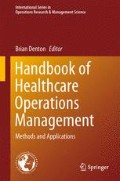Abstract
Decisions regarding the best use of scarce health resources become increasingly complex in developing countries due to high disease incidence, poor healthcare system infrastructure, and other societal factors. We develop a resource allocation model for the design of an Indoor Residual Spraying (IRS) program for malaria prevention in developing countries. Due to the seasonal nature of malaria risk factors, the model addresses dynamic resource allocation based on the risk characteristics. Using the model as a framework, a decision support tool for IRS operations is constructed. With a small numerical example we demonstrate the value of the tool for evaluating complexities and tradeoffs in the allocation of limited resources for an IRS program and the impact of heuristic decision making.
Access this chapter
Tax calculation will be finalised at checkout
Purchases are for personal use only
References
Alistar S, Brandeau ML (2012) Decision making for HIV prevention and treatment scale up bridging the gap between theory and practice. Med Decis Making 32(1):105–117
Balcik B, Beamon B, Smilowitz K (2008) Last mile distribution in Humanitarian relief. J Intell Transport Syst 12(2):51–63
Brandeau ML, Zaric GS, Richter A (2003) Resource allocation for control of infectious diseases in multiple independent populations: Beyond cost-effectiveness analysis. J Health Econ 22(4):575–598
Carr CC, Jallah JD (2008) Improving spatial accessibility to antiretroviral treatments for HIV/AIDS. Ph.D. thesis, University of Zaragoza
Centers for Disease Control and Prevention Division of Parasitic Disease: Malaria Worldwide - Impact of Malaria (2010) Accessed 1 May, 2012. http://www.cdc.gov/malaria/malaria_worldwide/impact.html
Cox J, Craig M, Le Sueur D, Sharp B (1999) Mapping malaria risk in the highlands of Africa. Tech. Rep., December 1999
Craig M, Snow R, Le Sueur D (1999) A climate-based distribution model of malaria transmission in sub-Saharan Africa. Parasitol Today 15(3):105–110
Deo S, Sohoni M (2011) Decentralization of resource-constrained health care networks: Access vs. accuracy tradeoff and network externality. http://papers.ssrn.com/sol3/papers.cfm?abstract_id=1754642
Epstein D, Chalabi Z, Claxton K, Sculpher M (2006) Mathematical programming for the optimal allocation of health care resources. https://www.york.ac.uk/media/che/documents/papers/mathprog.pdf
Flessa S (2000) Where efficiency saves lives: A linear programme for the optimal allocation of health care resources in developing countries. Health Care Manag Sci 3:249–267
Hansen K, Chapman G (2008) Setting priorities for the health care sector in Zimbabwe using cost-effectiveness analysis and estimates of the burden of disease. Cost Effect Resource Allocation 6(1):14
Kiszewski A, Johns B, Schapira A, Delacollette C, Crowell V, Tan-Torres T, Ameneshewa B, Teklehaimanot A, Nafo-Traoré F (2007) Estimated global resources needed to attain international malaria control goals. Bull World Health Organ 85(8):623–630
Lasry A, Zaric GS, Carter MW (2007) Multi-level resource allocation for HIV prevention: A model for developing countries. Eur J Oper Res 180(2):786–799
Lasry A, Carter MW, Zaric GS (2008) S4HARA: System for HIV/AIDS resource allocation. Cost Effect Resource Allocation 6:7
Lee B, Brown S, Korch G, Cooley P, Zimmerman R, Wheaton W, Zimmer S, Grefenstette J, Bailey R, Assi T, Burke DS (2010) A computer simulation of vaccine prioritization, allocation, and rationing during the 2009 H1N1 influenza pandemic. Vaccine 28(31):4875–4879
Mapping Malaria Risk in Africa: Mapping Malaria Risk in Africa (2004) http://www.mara.org.za
Ndiaye M, Alfares H (2008) Modeling health care facility location for moving population groups. Comp Oper Res 35(7):2154–2161
Oppong J (1996) Accommodating the rainy season in third World location-allocation applications. Soc-Econ Plann Sci 30(2):121–137
Over M, Bakote’e B, Velayudhan R, Wilikai P, Graves PM (2004) Impregnated nets or DDT residual spraying? Field effectiveness of malaria prevention techniques in Solomon Islands, 1993–1999. Am J Trop Med Hyg 71(Suppl 2):214–223
Rahman S, Smith DK (2000) Use of location-allocation models in health service development planning in developing nations. Eur J Oper Res 123(3):437–452. doi:10.1016/S0377-2217(99)00289-1
Snow RW, Guerra CA, Mutheu JJ, Hay SI (2008) International funding for malaria control in relation to populations at risk of stable Plasmodium falciparum transmission. PLoS Med 5(7):e142
Thomson MC, Doblas-Reyes FJ, Mason SJ, Hagedorn R, Connor SJ, Phindela T, Morse AP, Palmer TN (2006) Malaria early warnings based on seasonal climate forecasts from multi-model ensembles. Nature 439:576–579
United Nations Foundation: Nothing but nets: About the campaign (2012) http://www.nothingbutnets.net/about-us/
Wilson D, Kahn J (2006) Predicting the epidemiological impact of antiretroviral allocation strategies in KwaZulu-Natal: The effect of the urban–rural divide. Proc Natl Acad Sci USA 103(38):14228–14233
Wilson DP, Blower SM (2005) Designing equitable antiretroviral allocation strategies in resource-constrained countries. PLoS Med 2(2):e50
World Health Organization: Public Health Mapping and GIS: The HealthMapper (2012) http://www.who.int/health_mapping/tools/healthmapper/en/
Zaric GS, Brandeau M (2002) Dynamic resource allocation for epidemic control in multiple populations. IMA J Math Appl Med Biol 19:235–255
Zaric GS, Brandeau ML (2001) Resource allocation for epidemic control over short time horizons. Math Biosci 171(1):33–58
Zaric GS, Brandeau ML (2007) A little planning goes a long way: Multilevel allocation of HIV prevention resources. Med Decis Making: Int J Soc Med Decis Making 27(1):71–81
Acknowledgements
We would like to acknowledge the work of Georgia Tech students Michele Cataldi, Christina Cho, Cesar Gutierrez, Jeff Hull, Phillip Kim, and Andrew Park, who developed the initial model and study from which the current decision support tool and model were created. Additionally, we would like to acknowledge Hannah Smalley and Mallory Soldner for their work in the development of the decision support tool and a related case study. This research is supported in part by Andrea L. Laliberte, the Harold R. and Mary Anne Nash Endowment, the Claudia L. and J. Paul Raines Endowment, and Richard and Charlene Zalesky.
Author information
Authors and Affiliations
Corresponding author
Editor information
Editors and Affiliations
Rights and permissions
Copyright information
© 2013 Springer Science+Business Media New York
About this chapter
Cite this chapter
Griffin, J., Keskinocak, P., Swann, J. (2013). Allocating Scarce Healthcare Resources in Developing Countries: A Case for Malaria Prevention. In: Denton, B. (eds) Handbook of Healthcare Operations Management. International Series in Operations Research & Management Science, vol 184. Springer, New York, NY. https://doi.org/10.1007/978-1-4614-5885-2_20
Download citation
DOI: https://doi.org/10.1007/978-1-4614-5885-2_20
Published:
Publisher Name: Springer, New York, NY
Print ISBN: 978-1-4614-5884-5
Online ISBN: 978-1-4614-5885-2
eBook Packages: Business and EconomicsBusiness and Management (R0)

